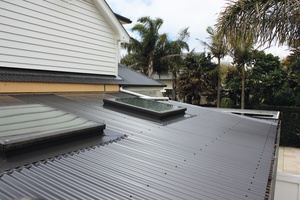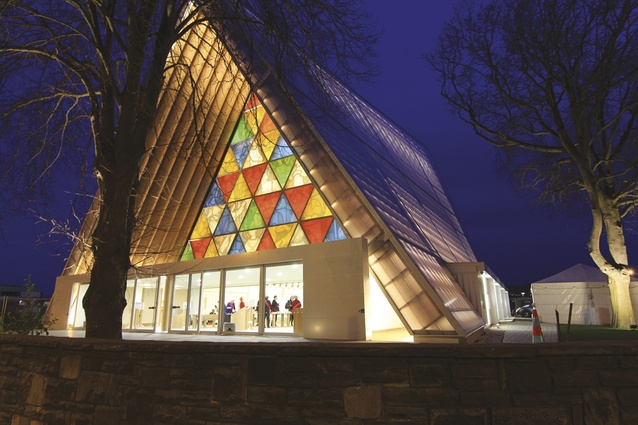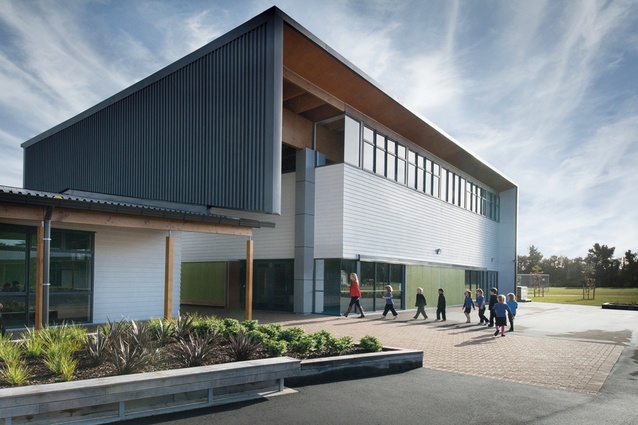From the rooftops
The Canterbury rebuild is providing a catalyst for developments in the New Zealand roofing industry, which is incorporating everything from warm roofs to paint technology as it moves forward.
Metal roofs are still king in New Zealand and their sustainable advantages are leading the way for new products. And the Canterbury earthquakes are another factor that have had a positive impact on the building and roofing industries, opening the doors to fresh ideas.
Japanese architect Shigeru Ban’s design of Canterbury’s transitional cathedral hit the headlines because cardboard tubes were used in its construction. But its polycarbonate roof deserves applause too. The Politec Modulit 338 panels supplied by Composite Insulation NZ were imported from Switzerland. Installed by Graham Hill Roofing, with secret fix junctions to the ridge line fixed back to purlins, their assembly used the tongue and groove method. Most of the sheets arrived in prearranged lengths but some cutting was needed to make them fit properly, with accuracy critical given the roof’s pitch and tolerances. The product’s advantages are structural strength, more interior light, and heat retention.
Graham Hill Roofing manager Mark Tinning, who is president of the New Zealand Roofing Association, says the city’s rebuild has offered a good chance for innovation, with more energy efficient buildings and growing use of glass for natural lighting.
Metal roofs are still the preference but the trend for ‘warm’ roofs – insulation from the outside – and better waterproofing is on the increase.
Fletcher Building company Dimond’s business development manager, Graham Moor, says the installation of warm roofs is quite an involved process.
“It has been out there for a long time but with some of the better membranes on the market today, they get better performance – they are all imports like Viking’s Ardex.” But, he says, imports come with a high social cost. “We can import but don’t come crying when people are being laid off.”
The sheet membranes in New Zealand are supplied in rolls, says VikingRoofspec manager Brendon Sutton, which he says is because of the predominance of timber substrates that have a tendency to move particularly during the change in seasons.
In the past, the market has been dominated by single ply butyl membranes supplied by Ardex and Viking and double-layered modified bitumen ones, mostly from Europe.
Now there are better waterproofing systems available, such as thermo-plastic polyolefins (TPOs). And warm roof insulation usually comes in the form of a rigid panel such as extruded polystyrene or closed cell foam, Sutton says.
“The installation of a correctly designed warm roof in New Zealand can save the building owner approximately 15 per cent in energy usage compared with a traditional cold roof. Although initially slow to gain traction, warm roofs have become more prominent in New Zealand over the last four years.”

Graham Moor says there is also a lot of noise around solar collection systems on roofs but he believes the free energy cost is still relatively high for the return. He believes steel offers good sustainable benefits, with its long life of between 30 and 40 years and ability to be recycled.
New metals that have gone from galvanised steel to zinc aluminium alloys and new coatings are also evolving. And paint systems are being developed so they behave differently, with cool colours coming onto the market so roofs do not get so hot. But he says cost is always going to be the main factor for Kiwis - although he does not advocate doing work on the cheap.
“Don’t expect it to be aesthetically pleasing or last. You get what you pay for. Just step back and have a look. If you want the cheapest, we can actually build nasty buildings. But will it stand the test of time in New Zealand? Does it meet our standards? People want it both ways - cheap and good. It’s hard to get.”
Building consultant Stuart Thomson says the government’s push for cheaper materials means there should be a very close watch on imported coil for metal roofing products.
“New Zealand is unique in having the worst UV, and marine and humid climates that attack metals and paints. Cheaper is not necessarily better – in fact, it usually is cheap and nasty.”
Thomson agrees price is the dictating factor in the country’s roofing industry and says warm roof designs have been slow to take off in the past for that reason. But, like Moor, he says improvements in paint technology are coming on stream all the time and new metal steel coatings will be out in the market place next year.
New Zealand Steel’s Chris Kay says COLORSTEEL® roofing remains the country’s favourite roofing brand by far and confirms a shift to lighter colours. “Over the last few years, there has been a shift in colour popularity towards the ‘greys’, with ‘ironsand’ being the most popular COLORSTEEL® colour. Specifiers have been telling us they want more choice of ‘greys’ and a better selection of ‘brighter whites’.”
The company has launched a new product called COLORSTEEL® BOUNCE™, which is a high performing solar reflectant developed for commercial and industrial buildings. It offers a thermal performance of 77 per cent and can help reduce air conditioning costs.
Kay says the company has also just launched its Architectural Series of seven new colours, each reflecting an aspect of the country’s flora, fauna, and landscape. Now he is predicting an upsurge in demand for greater function as well as performance from roofs, with an increase in the use of solar photovoltaic products.
He says a move by designers towards building integrated photovoltaic systems being incorporated into the roof will provide solar energy as well as solar heated water. Another trend he detects is a greater drive to change the way buildings are constructed because of the spotlight on affordability, with Housing New Zealand as the “demand catalyst”.
Key believes new methods of construction will include prefabrication, modularisation and standardisation. “Organisations such as PrefabNZ have worked hard to promote some of these concepts by pointing to overseas examples.”
Meanwhile Steel and Tube has just launched a new machine in Christchurch, as a result of the rebuild activity, to strengthen its roofing, wire-processing and reinforcing capability. The dual-level-long run-roll forming machine means the company will have greater capacity to manufacture its ST900 and ST963 metal roofing profiles. It offers a number of services including computer-aided component cutting.
Steel and Tube manager Mark Waterman says another technological advance that will impact on the roofing industry is greater sophistication in computer technology. “It allows more thorough appraisal of proposed roofing products’ performance under load to allow optimising of profile shape before investing in tooling.”
He says the development of roofing standards by the New Zealand Roofing Association and New Zealand Metal Roofing Manufacturers Code of Practice – and more recently because of the Licensed Building Practitioners scheme – has had a big impact.
He says standards have risen over the past 10 years and will continue to do so. Safety standards are also undergoing change with new agency WorkSafe established in December and a new bill being introduced into parliament.
The Health and Safety at Work Bill will eventually replace the Health and Safety in Employment Act, which has been in place since 1992. Graham Moor says the government is on the right path but there is more work to do. “People are still falling off,” he says. “They haven’t absolutely nailed it. It’s like the seatbelt rule. To me, this is the same.”
He believes it would help if employers were able to test for drugs and alcohol at any time. “You need to have just cause currently, within an employment contract that lets you test. It’s about protecting the worker and fellow workers, who want to know the person they’re with is safe to be with. Let’s make sure the guy or girl is not under the influence.”
He says penalties proposed in the bill for unsafe practices will have little effect and recommends better education as key to reducing accidents. The bill is expected to be enacted by December 2014.












